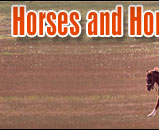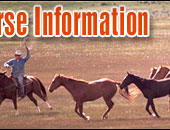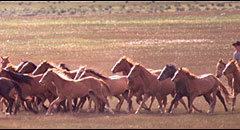 |
   |
|
|
|
You are here: Horses > Horse barns / fencing > Fire prevention |
Fire Safety & Prevention for Horse Barns and Stables
Barns and stables, filled with highly flammable hay,
bedding, and feed, are a big fire risk. Add the presence of
panicked animals and you have a recipe for a disaster if a
fire breaks out. |
|
|
Unfortunately, stable fires aren’t an uncommon occurrence.
If you look in most stables, you can find wet hay stored
near horses, oily rags, cigarette smoking, and overloaded or
damaged electrical wiring and heaters. All these are leading
causes of fires. But these expensive and tragic disasters can be simply
prevented by understanding the problem.
Hay is often stored in the same barn or stable with
horses to save time and cost. |
This usually causes no problems, but
many owners don’t realize that improperly cured and baled
hay can cause a fire. Even good hay stored under a leaking
roof can start fires. The best ways to prevent hay fires are
to keep hay in a separate location, and make sure it is dry
when stored and stays dry in storage.
There are many other causes of fires. Some common ones and
ways of preventing them:
- Overloaded or damaged extension cords. The simple solution
to this one is just to not use extension cords. If it is
unavoidable, use heavy-duty cords and only use one appliance
per cord.
- Damaged electrical wires—often caused by rodents, damaged
wires can spark fires. Replace the damaged wires instead of
wrapping them with electrical tape, which does not fix the
problem. To prevent rodents from chewing wiring, run it
through metal conduits rather than plastic or PVC ones.
Also, stringing wires over nails can result in the
insulation being damaged over the nail, causing a risk of
fires. All wires should be properly strung through metal
conduits.
- Dust from hay or bedding. When this collects on electrical
appliances, heaters, and fans, it can combust and start
fires. Clean the interior of electric appliances regularly
to prevent the dust from building up.
- Smoking, if allowed at all on the ranch, should never be
allowed in or near the barn. Smokers should light up no less
than twenty feet from the barns.
- Improper use of heaters—Heaters that blow directly on
bedding, rags, or hay can cause severe fires because the
heaters are often left unattended. Read the heater’s
directions carefully, and make sure they blow into an open
area free of flammable materials.
- Rags and paper towels used to clean tack and hooves can
spontaneously combust if soaked with oil or petroleum
products and left in a pile. Don’t leave these rags in a
heap. If they are stored so that the heat can safely
dissipate into the air, rather than remaining trapped in a
pile, there is little risk of fire.
The keys to saving lives—both human and equine—and property
are early detection and quick responses. Stables, which are
airy and filled with flammable materials, burn easily and
quickly, so a fast response is essential. Indeed, many
insurance companies consider a barn that is more than five
miles away from a fire station to be essentially unprotected
in the event of fire.
This is why smoke detectors are so important. Many fires
will smolder, smoke, and give off gases before bursting into
flame. Smoke detectors can sense these gases long before the
building heats to the point where a heat detector is
activated.
If a fire is detected, it is essential to respond as rapidly
as possible. Some smoke and heat detectors can be set up to
automatically alarm the closest fire station, either by an
electronic message, automatic dialing, or other systems. If
you have a fire in your barn or stable, here are the
essential steps to take right away:
- Immediately call the fire department or dial 911. Make
sure that you clearly state that you have a fire in
progress, and give the address of the fire. Don’t hang up
until you are sure that the operator or emergency responder
understands that there is a fire and has your correct
address.
- Warn everyone both in the inflamed building and in
surrounding buildings.
- Evacuate all the horses and animals from the burning
building and surrounding stables into the pastures.
- Switch off the power to the burning barn.
- Start fighting the fire as lined out in your fire plan.
You will likely be unable to quench the fire, but your
objective is simply to prevent it from spreading until the
fire department arrives.
- Focus. Have one person in charge to prevent confusion and
loss of time.
Of course, an ounce of prevention is worth a pound of cure.
Taking the time now to perform these fire prevention steps
can save a costly and dangerous fire later.
- Clean the interior of electrical appliances, like fans and
heaters.
- Get rid of all lightweight or home-use extension cords. If
the use of extension cords is unavoidable, replace them with
industrial grade ones.
- Store hay in a separate shed or barn, and buy only dry,
well-cured hay. Make sure to keep the hay dry to prevent
spontaneous combustion.
- Store rags and cloths used to clean tack and hooves in a
separate shed, when possible. Wherever they are stored, make
sure they are not heaped into a pile.
- Do not string wires and electric cords over nails. Replace
all damaged or inappropriately run wiring with properly
insulated wiring, strung through metal conduits.
- Invest in cages around light fixtures. This prevents
damage and sparking.
- Store bedding materials away from the stable.
- New buildings should be at least fifty feet, and ideally
seventy-five feet, away from existing buildings. This
reduces the risk of fires spreading between barns.
- Frost-proof water hydrants should be installed near the
entrances to each barn or large building on the ranch or
farm, and it should also have a hose long enough to reach
the far end of the stable, barn, or building.
- Make sure that everyone is familiar with the fire plan.
Post it in break areas in barns.
- Make sure that your electrical system allows the power to
be shut off to each building, without losing power to the
water pumps.

|
Read the next horse barns article on Horse Barn Basics. |
|
|
|
|
 |
|
|
|
|
|
Horse Education
|
|
|
|
|
Horse Information Topics
|
|
|
|
|
|
|
|
Horse Business Owners
|
| |
Advertise with Us
Have your horse products or services exposed to over 27,000 of our monthly visitors.
|
|
|
|
|
|